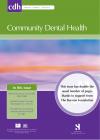Community Dental Health

- Cover Date:
- March 2011
- Print ISSN:
- 0265 539X
- Vol:
- 28
- Issue:
- 1
Factors associated with Japanese dentists encouraging patients to use dental floss
Objective The objective of this study was to clarify to what extent Japanese dentists recommend dental floss and what factors influence dentists in encouraging their patients to use dental floss. Participants The subjects in this study were 291 dentists who were directors of dental clinics, selected by stratified sampling by age. Results Dentists whose teachers at dental school had demonstrated dental flossing tended to recommend patients to use dental floss 2.2 (1.0-4.6: 95% CI) times more frequently compared with those who did not see demonstrations of flossing at dental school. Respondents who considered that using dental floss was very easy and easy, moderate, and difficult recommended patients to use dental floss 45.4 (11.2-183.9), 17.4 (6.6-45.8) and 5.9 (2.5-14.1) times more frequently, respectively, compared with those who considered it very difficult. Respondents who considered that using dental floss was effective, fairly effective or very effective in preventing dental caries recommended patients to use dental floss 3.8 (1.7-8.6), 3.8 (1.7-8.8) and 9.1 (3.6-23.0) times more frequently respectively, compared with those who considered it ineffective or only slightly effective. Conclusions The demonstration of the use of dental floss by teachers at their dental schools gave dentists a good impression and a positive opinion of dental flossing. This was closely associated with recommendations by dentists to their patients to use dental floss.
Key words: Dental floss, dentist, impression, opinions, questionnaire survey.
- Article Price
- £15.00
- Institution Article Price
- £0.00
- Page Start
- 111
- Page End
- 115
- Authors
- F. Nakamura, Y. Hirayama, I. Morita, H. Nakagaki
Articles from this issue
- Title
- Pg. Start
- Pg. End
- The caries experience of 5 year-old children in Scotland, Wales and England in 2007-2008 and the impact of consent arrangements. Reports of co-ordinated surveys using BASCD criteria
- 5
- 11
- The dilemma of selecting suitable proximal carious lesions in primary molars for restoration using ART technique.
- 12
- 16
- Using laser fluorescence (DIAGNOdent) in surveys for the detection of noncavitated occlusal dentine caries
- 17
- 21
- The prevalence of and risk factors for non-carious cervical lesions in adults in Hubei Province, China
- 22
- 28
- Health-related lifestyle behaviours, socio-demographic characteristics and use of dental health services in Greek adults.
- 47
- 52
- Periodontal health and treatment needs among hospitalized chronic psychiatric patients in Istanbul, Turkey
- 69
- 74
- Comparison of the COHIP and OHIP- 14 as measures of the oral health-related quality of life of adolescents
- 82
- 88
- Assessment and comparison of periodontal status among young smokers and nonsmokers of Bangalore, India - a cross sectional study.
- 89
- 94
- Smoking and drinking habits and attitudes to smoking cessation counselling among Tanzanian dental students
- 95
- 98
- Traumatic dental injuries to primary incisors and the terminal or occlusal plane relationship in Indian preschool children
- 104
- 106
- Teaching dental public health to undergraduates using community profiles and patient case studies
- 116
- 120
